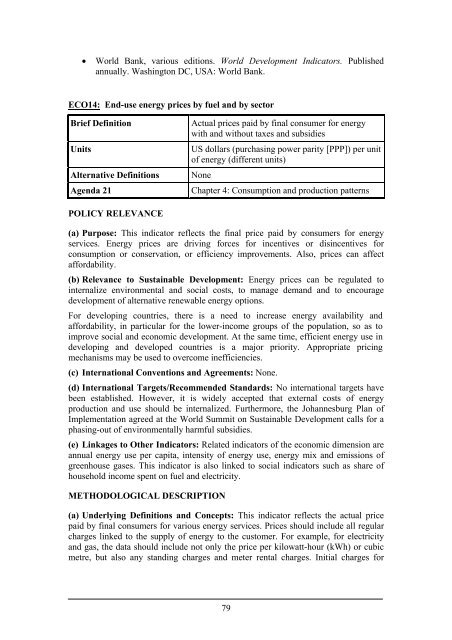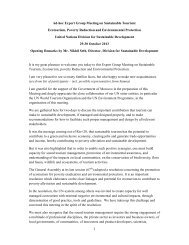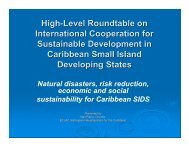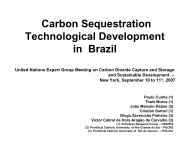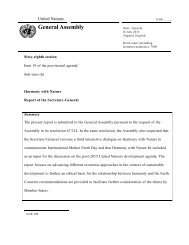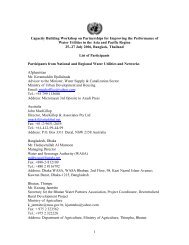ASSESSMENT OF DATA(a) Data Needed to Compile the Indicator: TPES, TFC, total electricity generationand generating capacity. Primary energy from renewable energy options, electricitygeneration and generating capacity from renewable energy options.(b) National and International Data Availability: Data on energy supply by fuel areavailable from national statistical offices and country publications, and from variousinternational sources, such as the International <strong>Energy</strong> Agency (IEA), the World Bankand Eurostat.REFERENCES• EEA, 2002. <strong>Energy</strong> and Environment in the European Union. Environmentalissue report no. 31. Copenhagen, Denmark: European Environment Agency.• Eurostat, various editions. <strong>Energy</strong> Balance Sheets. Luxembourg, Eurostat.• Eurostat, various editions. Pocketbook on <strong>Energy</strong>, Transport and Environment.Luxembourg: Eurostat.• Eurostat, various editions. Pocketbook on Renewable <strong>Energy</strong> Statistics in theEU. Luxembourg: Eurostat.• IEA, 2001. Key World <strong>Energy</strong> Statistics from the IEA. Paris, France:International <strong>Energy</strong> Agency.• IEA, various editions. <strong>Energy</strong> Balances of Non-OECD Countries. Paris,France: International <strong>Energy</strong> Agency.• IEA, various editions. <strong>Energy</strong> Balances of OECD Countries. Paris, France:International <strong>Energy</strong> Agency.• IEA, various editions. <strong>Energy</strong> Statistics of Non-OECD Countries. Paris,France: International <strong>Energy</strong> Agency.• IEA, various editions. <strong>Energy</strong> Statistics of OECD Countries. Paris, France:International <strong>Energy</strong> Agency.• UNSD, 1982. Concepts and Methods in <strong>Energy</strong> Statistics, with SpecialReference to <strong>Energy</strong> Accounts and Balances — A Technical Report. NewYork, NY, USA: United Nations Statistics Division.• UNSD, 1987. <strong>Energy</strong> Statistics: Definitions, Units of Measure and ConversionFactors. New York, USA: United Nations Statistics Division.• UNSD, 1991. <strong>Energy</strong> Statistics: A Manual <strong>for</strong> Developing Countries. NewYork, USA: United Nations Statistics Division.• UNSD, various editions. <strong>Energy</strong> Balances and Electricity Profiles. Publishedbiennially. New York, USA: United Nations Statistics Division.• UNSD, various editions. <strong>Energy</strong> Statistics Yearbook. Published annually. NewYork, USA: United Nations Statistics Division.78
• World Bank, various editions. World <strong>Development</strong> <strong>Indicators</strong>. Publishedannually. Washington DC, USA: World Bank.ECO14: End-use energy prices by fuel and by sectorBrief DefinitionUnitsAlternative DefinitionsAgenda 21Actual prices paid by final consumer <strong>for</strong> energywith and without taxes and subsidiesUS dollars (purchasing power parity [PPP]) per unitof energy (different units)NoneChapter 4: Consumption and production patternsPOLICY RELEVANCE(a) Purpose: This indicator reflects the final price paid by consumers <strong>for</strong> energyservices. <strong>Energy</strong> prices are driving <strong>for</strong>ces <strong>for</strong> incentives or disincentives <strong>for</strong>consumption or conservation, or efficiency improvements. Also, prices can affectaf<strong>for</strong>dability.(b) Relevance to <strong>Sustainable</strong> <strong>Development</strong>: <strong>Energy</strong> prices can be regulated tointernalize environmental and social costs, to manage demand and to encouragedevelopment of alternative renewable energy options.For developing countries, there is a need to increase energy availability andaf<strong>for</strong>dability, in particular <strong>for</strong> the lower-income groups of the population, so as toimprove social and economic development. At the same time, efficient energy use indeveloping and developed countries is a major priority. Appropriate pricingmechanisms may be used to overcome inefficiencies.(c) International Conventions and Agreements: None.(d) International Targets/Recommended Standards: No international targets havebeen established. However, it is widely accepted that external costs of energyproduction and use should be internalized. Furthermore, the Johannesburg Plan ofImplementation agreed at the World Summit on <strong>Sustainable</strong> <strong>Development</strong> calls <strong>for</strong> aphasing-out of environmentally harmful subsidies.(e) Linkages to Other <strong>Indicators</strong>: Related indicators of the economic dimension areannual energy use per capita, intensity of energy use, energy mix and emissions ofgreenhouse gases. This indicator is also linked to social indicators such as share ofhousehold income spent on fuel and electricity.METHODOLOGICAL DESCRIPTION(a) Underlying Definitions and Concepts: This indicator reflects the actual pricepaid by final consumers <strong>for</strong> various energy services. Prices should include all regularcharges linked to the supply of energy to the customer. For example, <strong>for</strong> electricityand gas, the data should include not only the price per kilowatt-hour (kWh) or cubicmetre, but also any standing charges and meter rental charges. Initial charges <strong>for</strong>79
- Page 2 and 3:
Photos on the cover:D. Kinley, IAEA
- Page 4 and 5:
COPYRIGHT NOTICEAll IAEA scientific
- Page 6 and 7:
IAEA Library Cataloguing in Publica
- Page 8 and 9:
agency report. Their work also bene
- Page 10 and 11:
Environmental Dimension ...........
- Page 12 and 13:
progress towards sustainability. Fi
- Page 15 and 16:
2. BACKGROUNDSince the publication
- Page 17 and 18:
presented in this report. A short d
- Page 19 and 20:
In the 2004 edition of the World En
- Page 21 and 22:
3. ENERGY INDICATORS FOR SUSTAINABL
- Page 23 and 24:
EconomicTheme Sub-theme Energy Indi
- Page 25 and 26:
EnvironmentalTheme Sub-theme Energy
- Page 27 and 28:
income. Inadequate equipment and ve
- Page 29 and 30:
the cost of delivery are necessary
- Page 31 and 32:
Paradoxically, the economic and env
- Page 33:
• Shares of sectors in GDP value
- Page 36 and 37:
might be collected by another, or t
- Page 38 and 39: 4.3. Priorities and Approaches for
- Page 40 and 41: (b) Relevance to Sustainable Develo
- Page 42 and 43: • IEA, various editions. Energy S
- Page 44 and 45: (b) National and International Data
- Page 46 and 47: energy availability and affordabili
- Page 48 and 49: SOC4: Accident fatalities per energ
- Page 50 and 51: Proceedings of a Technical Committe
- Page 52 and 53: REFERENCES• IEA, various editions
- Page 54 and 55: geography and the structure of the
- Page 56 and 57: (b) Relevance to Sustainable Develo
- Page 58 and 59: • UNSD, various editions. Energy
- Page 60 and 61: • USGS, various editions. World P
- Page 62 and 63: ECO6: Industrial energy intensities
- Page 64 and 65: Units: toe for final energy and kWh
- Page 66 and 67: • Unander, F., Karbuz, S., Schipp
- Page 68 and 69: other inputs, etc). These factors a
- Page 70 and 71: (d) International Targets/Recommend
- Page 72 and 73: ASSESSMENT OF DATA(a) Data Needed t
- Page 74 and 75: oilers and new electric appliances
- Page 76 and 77: Disaggregated Intensities: Using th
- Page 78 and 79: educe the environmental impacts of
- Page 80 and 81: (d) Alternative Definitions/Indicat
- Page 82 and 83: (c) International Conventions and A
- Page 84 and 85: ECO12: Non-carbon energy share in e
- Page 86 and 87: • IEA, 1990-2001. Energy Statisti
- Page 90 and 91: connection to the electricity or ga
- Page 92 and 93: Further problems include differing
- Page 94 and 95: Re-exports of oil imported for proc
- Page 96: (c) International Conventions and A
- Page 99 and 100: does not show how much the climate
- Page 101 and 102: • World Bank, various editions. W
- Page 103 and 104: a time frame as possible so that lo
- Page 105 and 106: ENV3: Air pollutant emissions from
- Page 107 and 108: METHODOLOGICAL DESCRIPTION(a) Under
- Page 109 and 110: In the first instance, countries sh
- Page 111 and 112: ENV4-1: Contaminant discharges in l
- Page 113 and 114: downstream. Contamination of fresh
- Page 115 and 116: ENV4-2: Oil discharges into coastal
- Page 117 and 118: (b) Measuring Methods: Estimates of
- Page 119 and 120: Acidification is a priority atmosph
- Page 121 and 122: national authorities under the CLRT
- Page 123 and 124: United Nations Convention to Combat
- Page 125 and 126: • Harcharik, D.A., 1995. Forest R
- Page 127 and 128: indicator, radioactive waste and (s
- Page 129 and 130: (b) Relevance to Sustainable Develo
- Page 131 and 132: more easily available, as in many c
- Page 133 and 134: Agency (IAEA). In 1995, the IAEA pu
- Page 135 and 136: • Low- and intermediate-level rad
- Page 137 and 138: ENV10: Ratio of solid radioactive w
- Page 139 and 140:
under development in some countries
- Page 141:
• IAEA, 1997. Joint Convention on
- Page 144 and 145:
EEA, 2002. Review of Selected Waste
- Page 146 and 147:
FAO, 1988. Energy Conservation in A
- Page 148 and 149:
IEA, 2000. The IEA Energy Indicator
- Page 150 and 151:
OECD, 2001. Key Environmental Indic
- Page 152 and 153:
UNEP/WHO, 1992. Urban Air Pollution
- Page 155 and 156:
RELATED INTERNET SITES• CONCAWE (
- Page 157:
• WEC (World Energy Council):http
- Page 160 and 161:
Particulates: Terms commonly associ
- Page 162 and 163:
TOCTPESTSPVOCtotal organic carbonto
- Page 165 and 166:
ANNEX 3: A DECOMPOSITION METHOD FOR
- Page 167 and 168:
Total Final ConsumptionHouseholds T
- Page 169 and 170:
Thus through calculating the relati
- Page 171:
Annex 4: Units and Conversion Facto


